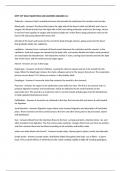NFPT CPT EXAM QUESTIONS AND ANSWERS (GRADED A+)
Tubercles - Answers Small, rounded processes that provide the attachment for tendons and muscles.
Blood path - Answers The blood that enters the right side of the heart is dark red (bluish) and is low in
oxygen; this blood travels from the right side of the heart along pulmonary arteries to the lungs, where
it receives fresh supplies of oxygen and becomes bright red. It then flows along pulmonary veins to the
heart's left side pump. Blood then leaves the
left side of the heart and travels to the rest of the body through arteries, going away from the heart,
that gradually divide into capillaries.
capillaries - Answers form a network of blood vessels between the arterioles and the venules. In the
capillaries, food and oxygen are released to the body cells, and carbon dioxide and other waste products
are returnedto the bloodstream. The blood then travels in veins, coming back towards and into the right
side of the heart; and the whole process begins again.
Alveoli - Answers air sacs in the lungs
Diaphragm - Answers contracts it flattens, causing the chest to expand and air to be sucked into the
lungs. When the diaphragm relaxes, the chest collapses and air in the lungs is forced out. The respiration
process occurs about 12-15 times per minute, in the healthy adult.
Esophagus - Answers A muscular tube that connects the mouth to the stomach.
Pancreas - Answers An organs in the abdominal cavity with two roles. The first is an exocrine role: to
produce digestive enzymes and bicarbonate, which are delivered to the small intestine via the
pancreatic duct. The second is an endocrine role: to secrete insulin and glucagon into the bloodstream
to help regulate blood glucose levels.
Gallbladder - Answers A muscular sac attached to the liver that secretes bile and stores it until needed
for digestion
small intestine - Answers Digestive organ where most chemical digestion and absorption of food takes
place. These nutrients are then carried away to the liver and other body parts to be processed, stored
and distributed.
liver - Answers Blood from the intestines flows to the liver, carrying nutrients, vitamins/miner- als, and
other products from digestion. The liver stores some nutrients, changes them from one form to another,
and then releases them into the blood according to the activities and bodily needs.
where are white blood cells found? - Answers lymph nodes, thymus gland, spleen, tonsils and adenoids
lymph nodes - Answers Lymph nodes, distributed widely throughout the body, act as filters - or germ
traps. They contain billions of white blood cells, which multiply rapidly to fight off invading pathogens.
, During illness from infection, lymph nodes fill up with millions of extra white cells and "dead" pathogens.
A noticeable swelling of the lymph nodes may occur and can be an indication of infection.
thymus gland - Answers The thymus gland, located in front of the heart and behind the sternum, is a
special- ized organ that produces and "educates" T-cells (T-lymphocyte cells). T-cells are orches- trated
in the thymus for the purpose of attacking foreign substances and responding to infected cells. The
thymus is larger and most active during childhood and through puberty; but, during the aging process,
will slowly shrink, eventually degenerating into tiny islands of fatty tissue.
spleen - Answers The spleen is located just behind the stomach, on the left side. It makes and stores
vari- ous kinds of white and red blood cells. Essentially, the spleen is a blood filter that func- tions in the
immune system to decrease susceptibility and fight off infection.
the master gland - Answers pituitary gland
pancreas - Answers an organ playing roles inthe digestive and endocrine systems,is an endocrine gland
that secretes thehormones insulin and glucagon for bloodsugar regulation
sagittal plane - Answers a vertical plane that divides the body into right and left parts, flexion/extension,
(squat, curl, lunge, walk)
frontal plane - Answers Divides the body into front and back portions, adduction/abduction, (lat raise,
pulldown, side bend, military press)
transverse plane - Answers horizontal division of the body into upper and lower portions,
internal/external rotation, rotation at waist
spine - Answers cervical(7 vert) thoracic (12 vert) lumbar (5 vert) sacral (sacrum 4-6 vert, coccyx 3-5 vert)
most common knee injury - Answers knee
quad muscles - Answers rectus femoris, vastus lateralis, vastus medialis, vastus intermedius
back muscles - Answers latissimus dorsi, teres major, rhomboids, traps, erector spinae
Epimysium - Answers a sheath of fibrous elastic tissue surrounding a muscle.
Endomysium - Answers Connective tissue surrounding a muscle fiber
myofibrils - Answers Myofibrils are the contractile components that allow for strength and performance
of the muscles, they are composed of repeating sarcomeres that giveskeletal muscle cells a striated
look, thus thename 'striated muscle'
Sarcomere - Answers he functional units of skeletal muscle occurring in repeating segments along the
myofibril,




